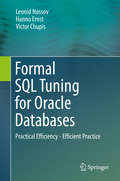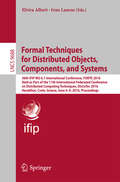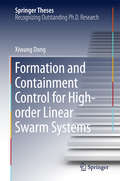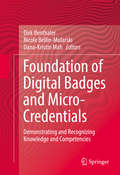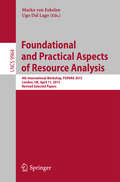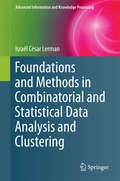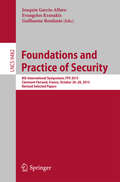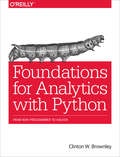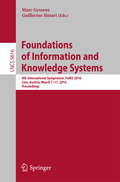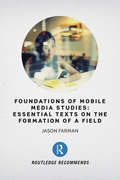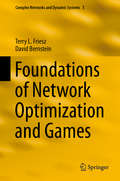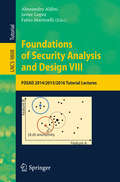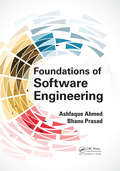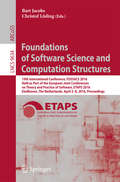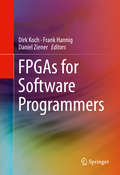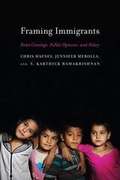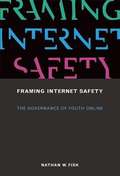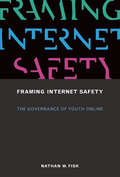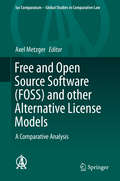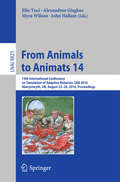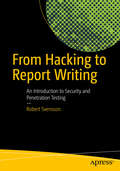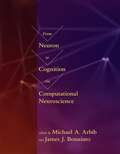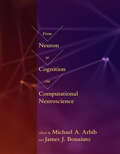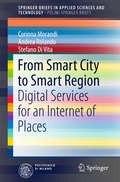- Table View
- List View
Formal SQL Tuning for Oracle Databases
by Leonid Nossov Hanno Ernst Victor ChupisThe target of SQL tuning is the improvement of the existing execution plan. The authors discuss the removal of brakes in the execution plan. Such "brakes" or bottlenecks can be recognized by a formal analysis of the execution plan. For this purpose no data model knowledge is needed. This is especially beneficial for database administrators because they are usually not or insufficiently familiar with the data model. The book presents numerous practical examples with this method.
Formal Techniques for Distributed Objects, Components, and Systems
by Elvira Albert Ivan LaneseThis book constitutes the proceedings of the 36th IFIP WG 6. 1 International Conference on Formal Techniques for Distributed Objects, Components, and Systems, FORTE 2016, held in Heraklion, Crete, Greece, in June 2016, as part of the 11th International Federated Conference on Distributed Computing Techniques, DisCoTec 2016. The 18 revised full papers presented were carefully reviewed and selected from 44 submissions. The papers present a wide range of topics on distributed computing models and formal specification, testing, and verification methods.
Formation and Containment Control for High-order Linear Swarm Systems
by Xiwang DongThis book focuses on analysis and design problems for high-order linear time-invariant (LTI) swarm systems (multi-agent systems) to achieve consensus, formation, containment and formation-containment. As a first step, the concepts of practical consensus and formation-containment are introduced. Unlike previous research, the formation in this book can be time-varying. A general framework for consensus, consensus tracking, formation, containment and state formation-containment is presented for the first time. Sufficient/necessary and sufficient conditions, and approaches to designing the protocols for swarm systems to achieve these control objectives, are respectively proposed. Autonomous time-varying formation experiments using five quadrotor unmanned aerial vehicles (UAVs) are conducted in an outdoor setting to demonstrate the theoretical results.
Foundation of Digital Badges and Micro-Credentials
by Dirk Ifenthaler Nicole Bellin-Mularski Dana-Kristin MahThis edited volume provides insight into how digital badgesmay enhance formal, non-formal and informal education by focusing on technicaldesign issues including organizational requirements, learning and instructionaldesign, as well as deployment. It features current research exploring thetheoretical foundation and empirical evidence of the utilization of digitalbadges as well as case studies that describe current practices and experiencesin the use of digital badges for motivation, learning, and instruction in K-12,higher education, workplace learning, and further education settings.
Foundational and Practical Aspects of Resource Analysis
by Marko Van Eekelen Ugo Dal LagoThis book constitutes the proceedings of the 4th International Workshop on Foundational and Practical Aspects of Resource Analysis, FOPARA 2015, held in London, UK, in April 2015. The 6 papers presented in this volume were carefully reviewed and selected from 7 submissions.
Foundations and Methods in Combinatorial and Statistical Data Analysis and Clustering
by Israël César LermanThis bookoffers an original and broad exploration of the fundamental methods in Clusteringand Combinatorial Data Analysis, presenting new formulations and ideas withinthis very active field. With extensive introductions, formal andmathematical developments and real case studies, this book provides readerswith a deeper understanding of the mutual relationships between these methods,which are clearly expressed with respect to three facets: logical,combinatorial and statistical. Usingrelational mathematical representation, all types of data structures can behandled in precise and unified ways which the author highlights in three stages: Clustering a set of descriptive attributes Clustering a set of objects or a set of objectcategories Establishing correspondence between these twodual clusterings Tools forinterpreting the reasons of a given cluster or clustering are also included. Foundations and Methods in Combinatorial andStatistical Data Analysis and Clustering will be a valuable resource for students andresearchers who are interested in the areas of Data Analysis, Clustering, DataMining and Knowledge Discovery.
Foundations and Practice of Security
by Joaquin Garcia-Alfaro Evangelos Kranakis Guillaume BonfanteThis book constitutes the thoroughly refereedpost-conference proceedings of the 8th International Symposium on Foundationsand Practice of Security, FPS 2015, held in Clermont-Ferrand, France, inOctober 2015. The 12 revised full papers presented together with 8short papers and 2 keynote talks were carefully reviewed and selected from 58submissions. The papers are organized in topical sections on RFID, sensors andsecure computation; security policies and biometrics; evaluation of protocolsand obfuscation security; spam emails, botnets and malware.
Foundations for Analytics with Python: From Non-Programmer to Hacker
by BrownleyIf you're like many of Excel's 750 million users, you want to do more with your data--like repeating similar analyses over hundreds of files, or combining data in many files for analysis at one time. This practical guide shows ambitious non-programmers how to automate and scale the processing and analysis of data in different formats--by using Python.After author Clinton Brownley takes you through Python basics, you'll be able to write simple scripts for processing data in spreadsheets as well as databases. You'll also learn how to use several Python modules for parsing files, grouping data, and producing statistics. No programming experience is necessary.Create and run your own Python scripts by learning basic syntaxUse Python's csv module to read and parse CSV filesRead multiple Excel worksheets and workbooks with the xlrd modulePerform database operations in MySQL or with the mysqlclient moduleCreate Python applications to find specific records, group data, and parse text filesBuild statistical graphs and plots with matplotlib, pandas, ggplot, and seabornProduce summary statistics, and estimate regression and classification modelsSchedule your scripts to run automatically in both Windows and Mac environments
Foundations of Information and Knowledge Systems
by Marc Gyssens Guillermo SimariThis book constitutes the proceedings of the 9th International Symposiumon Foundations of Information and Knowledge Systems, FoIKS 2016, held in Linz,Austria, in March 2016. The 14 revised full papers presented papers werecarefully reviewed and selected from 23 submissions. The papers address varioustopics such as reasoning about beliefs, uncertainty, incompleteness, andinconsistency, inference and problem solving, querying and pattern mining,dealing with knowledge, logics and complexity.
Foundations of Mobile Media Studies: Essential Texts on the Formation of a Field (Routledge Recommends)
by Jason FarmanFoundations of Mobile Media Studies gathers some of the most important texts in this emerging field, offering readers key approaches to understanding our moment and our media. The impact of mobile media is far reaching and this book discusses topics such as human intimacy, social space, political uprisings, labor, mobile phones in the developing world, gender, the mobile device’s impact on reading, mobile television, and mobile photography, among others. This carefully curated collection will serve as the central text to introduce this field to anyone eager to understand the rise of mobile technology, its impact on our relationships, and how these media have transformed the ways we understand the world around us.
Foundations of Network Optimization and Games
by Terry L. Friesz David BernsteinThis is a book about infrastructure networks that are intrinsically nonlinear. The networks considered range from vehicular networks to electric power networks to data networks. The main point of view taken is that of mathematical programming in concert with finite-dimensional variational inequality theory. The principle modeling perspectives are network optimization, the theory of Nash games, and mathematical programming with equilibrium constraints. Computational methods and novel mathematical formulations are emphasized. Among the numerical methods explored are network simplex, gradient projection, fixed-point, gap function, Lagrangian relaxation, Dantzig-Wolfe decomposition, simplicial decomposition, and computational intelligence algorithms. Many solved example problems are included that range from simple to quite challenging. Theoretical analyses of several models and algorithms, to uncover existence, uniqueness and convergence properties, are undertaken. The book is meant for use in advanced undergraduate as well as doctoral courses taught in civil engineering, industrial engineering, systems engineering, and operations research degree programs. At the same time, the book should be a useful resource for industrial and university researchers engaged in the mathematical modeling and numerical analyses of infrastructure networks.
Foundations of Security Analysis and Design VIII
by Alessandro Aldini Javier Lopez Fabio MartinelliFOSAD has been one of the foremost educational events established with the goal of disseminating knowledge in the critical area of security in computer systems and networks. Over the years, both the summer school and the book series have represented a reference point for graduate students and young researchers from academia and industry, interested to approach the field, investigate open problems, and follow priority lines of research. This book presents thoroughly revised versions of four tutorial lectures given by leading researchers during three International Schools on Foundations of Security Analysis and Design, FOSAD, held in Bertinoro, Italy, in September 2014, 2015 and 2016. The topics covered in this book include zero-knowledge proof systems, JavaScript sandboxing, assessment of privacy, and distributed authorization.
Foundations of Software Engineering
by Ashfaque Ahmed Bhanu PrasadThe best way to learn software engineering is by understanding its core and peripheral areas. Foundations of Software Engineering provides in-depth coverage of the areas of software engineering that are essential for becoming proficient in the field. The book devotes a complete chapter to each of the core areas. Several peripheral areas are also explained by assigning a separate chapter to each of them. Rather than using UML or other formal notations, the content in this book is explained in easy-to-understand language. Basic programming knowledge using an object-oriented language is helpful to understand the material in this book. The knowledge gained from this book can be readily used in other relevant courses or in real-world software development environments.This textbook educates students in software engineering principles. It covers almost all facets of software engineering, including requirement engineering, system specifications, system modeling, system architecture, system implementation, and system testing. Emphasizing practical issues, such as feasibility studies, this book explains how to add and develop software requirements to evolve software systems.This book was written after receiving feedback from several professors and software engineers. What resulted is a textbook on software engineering that not only covers the theory of software engineering but also presents real-world insights to aid students in proper implementation. Students learn key concepts through carefully explained and illustrated theories, as well as concrete examples and a complete case study using Java. Source code is also available on the book’s website. The examples and case studies increase in complexity as the book progresses to help students build a practical understanding of the required theories and applications.
Foundations of Software Science and Computation Structures
by Christof Löding Bart JacobsThis book constitutes the proceedings of the 19thInternational Conference on Foundations of Software Science and ComputationStructures, FOSSACS 2016, which took place in Eindhoven, The Netherlands, inApril 2016, held as Part of the European Joint Conferences on Theory andPractice of Software, ETAPS 2016. The 31 full papers presented in this volume werecarefully reviewed and selected from 85 submissions. They were organized intopical sections named: types; recursion and fixed-points; verification andprogram analysis; automata, logic, games; probabilistic and timed systems;proof theory and lambda calculus; algorithms for infinite systems; and monads.
FPGAs for Software Programmers
by Dirk Koch Frank Hannig Daniel ZienerThis book makes powerful Field Programmable GateArray (FPGA) and reconfigurable technology accessible to software engineers bycovering different state-of-the-art high-level synthesis approaches (e. g. ,OpenCL and several C-to-gates compilers). It introduces FPGA technology, itsprogramming model, and how various applications can be implemented on FPGAswithout going through low-level hardware design phases. Readers will get arealistic sense for problems that are suited for FPGAs and how to implementthem from a software designer's point of view. The authors demonstrate that FPGAs and their programming model reflectthe needs of stream processing problems much better than traditional CPU or GPUarchitectures, making them well-suited for a wide variety of systems, fromembedded systems performing sensor processing to large setups for Big Datanumber crunching. This book serves as aninvaluable tool for software designers and FPGA design engineers who are interestedin high design productivity through behavioural synthesis, domain-specificcompilation, and FPGA overlays. Introduces FPGA technology to softwaredevelopers by giving an overview of FPGA programming models and design tools,as well as various application examples; Provides a holistic analysis of the topic andenables developers to tackle the architectural needs for Big Data processingwith FPGAs; Explains the reasons for the energy efficiencyand performance benefits of FPGA processing; Provides a user-orientedapproach and a sense for where and how to apply FPGA technology.
Fragments of an Infinite Memory: My Life with the Internet
by Mael RenouardA deeply informed, yet playful and ironic look at how the internet has changed human experience, memory, and our sense of self, and that belongs on the shelf with the best writings of Roland Barthes and Jean Baudrillard.&“One day, as I was daydreaming on the boulevard Beaumarchais, I had the idea—it came and went in a flash, almost in spite of myself—of Googling to find out what I&’d been up to and where I&’d been two evenings before, at five o&’clock, since I couldn&’t remember on my own.&” So begins Maël Renouard&’s Fragments of an Infinite Memory, a provocative and elegant inquiry into life in a wireless world. Renouard is old enough to remember life before the internet but young enough to have fully accommodated his life to the internet and the gadgets that support it. Here this young philosopher, novelist, and translator tries out a series of conjectures on how human experience, especially the sense of self, is being changed by our continual engagement with a memory that is impersonal and effectively boundless. Renouard has written a book that is rigorously impressionistic, deeply informed historically and culturally, but is also playful, ironic, personal, and formally adventurous, a book that withstands comparison to the best of Roland Barthes and Jean Baudrillard.
Framing Immigrants: News Coverage, Public Opinion, and Policy
by Chris Haynes Jennifer Merolla S. Karthick RamakrishnanWhile undocumented immigration is controversial, the general public is largely unfamiliar with the particulars of immigration policy. Given that public opinion on the topic is malleable, to what extent do mass media shape the public debate on immigration? In Framing Immigrants, political scientists Chris Haynes, Jennifer Merolla, and Karthick Ramakrishnan explore how conservative, liberal, and mainstream news outlets frame and discuss undocumented immigrants. Drawing from original voter surveys, they show that how the media frames immigration has significant consequences for public opinion and has implications for the passage of new immigration policies. The authors analyze media coverage of several key immigration policy issues—including mass deportations, comprehensive immigration reform, and measures focused on immigrant children, such as the DREAM Act—to chart how news sources across the ideological spectrum produce specific “frames” for the immigration debate. In the past few years, liberal and mainstream outlets have tended to frame immigrants lacking legal status as “undocumented” (rather than “illegal”) and to approach the topic of legalization through human-interest stories, often mentioning children. Conservative outlets, on the other hand, tend to discuss legalization using impersonal statistics and invoking the rule of law. Yet, regardless of the media’s ideological positions, the authors’ surveys show that “negative” frames more strongly influence public support for different immigration policies than do positive frames. For instance, survey participants who were exposed to language portraying immigrants as law-breakers seeking “amnesty” tended to oppose legalization measures. At the same time, support for legalization was higher when participants were exposed to language referring to immigrants living in the United States for a decade or more. Framing Immigrants shows that despite heated debates on immigration across the political aisle, the general public has yet to form a consistent position on undocumented immigrants. By analyzing how the media influences public opinion, this book provides a valuable resource for immigration advocates, policymakers, and researchers.
Framing Internet Safety: The Governance of Youth Online
by Nathan W. FiskSince the beginning of the Internet era, it has become almost impossible to discuss youth and technology without mentioning online danger -- pornography that is just a click away, lurking sexual predators, and inescapable cyberbullies. In this book, Nathan Fisk takes an innovative approach to the subject, examining youth Internet safety as a technology of governance -- for information technologies and, by extension, for the forms of sociality and society they make possible. He argues that it is through the mobilization of various discourses of online risk that the everyday lives of youth are increasingly monitored and policed and the governing potentials of information technologies are explored. Fisk relates particular panics over youth Internet safety to patterns of technological adoption by young people, focusing on the policy response at the federal level aimed at producing future cybercitizens. He describes pedagogies of surveillance, which position parents as agents of surveillance; the evolution of the youth Internet safety curricula, as seen through materials on cyberbullying and online reputation management; and, drawing on survey results and focus groups, parent and child everyday practice. Finally, Fisk offers recommendations for a "cybersafety of everyday life," connecting youth Internet safety to trends in national infrastructure protection and corporate information assurance.
Framing Internet Safety: The Governance of Youth Online (The John D. and Catherine T. MacArthur Foundation Series on Digital Media and Learning)
by Nathan W. FiskAn examination of youth Internet safety as a technology of governance, seen in panics over online pornography, predators, bullying, and reputation management.Since the beginning of the Internet era, it has become almost impossible to discuss youth and technology without mentioning online danger—pornography that is just a click away, lurking sexual predators, and inescapable cyberbullies. In this book, Nathan Fisk takes an innovative approach to the subject, examining youth Internet safety as a technology of governance—for information technologies and, by extension, for the forms of sociality and society they make possible. He argues that it is through the mobilization of various discourses of online risk that the everyday lives of youth are increasingly monitored and policed and the governing potentials of information technologies are explored. Fisk relates particular panics over youth Internet safety to patterns of technological adoption by young people, focusing on the policy response at the federal level aimed at producing future cybercitizens. He describes pedagogies of surveillance, which position parents as agents of surveillance; the evolution of the youth Internet safety curricula, as seen through materials on cyberbullying and online reputation management; and, drawing on survey results and focus groups, parent and child everyday practice. Finally, Fisk offers recommendations for a “cybersafety of everyday life,” connecting youth Internet safety to trends in national infrastructure protection and corporate information assurance.
Free and Open Source Software (FOSS) and other Alternative License Models
by Axel MetzgerThis book discusses the main legal questions raised by free and open source software (FOSS) licenses and other alternative license models, such as Creative Commons. The legal questions raised by FOSS and other alternative licenses have been the subject of an intense international debate among legal scholars and practising lawyers in the last years. Courts in different jurisdictions have confirmed that the core features of FOSS licenses are compliant with the respective applicable laws and thus enforceable in the respective jurisdictions. What is still missing so far is an in-depth comparative analysis of the legal issues raised by FOSS, Creative Commons and other alternative license on a worldwide scale. This book presents a general report on FOSS licenses and alternative license models to establish common ground and enable comparison between jurisdictions. The general report is followed by 24 national reports covering the world's most important IT-markets. General and national reports use the same structure to facilitate the comparison. The book shows that despite the differences in their origins, all FOSS projects use detailed licenses for the organisation of their communities. It also shows the differences in the proofing of these licenses by courts in some jurisdictions and the tailor-made provisions established by some legislators to solve the legal issues raised by the license model.
From Animals to Animats 14
by John Hallam Myra Wilson Alexandros Giagkos Elio TuciThis book constitutes the proceedings of the 14th International Conference on Simulation of Adaptive Behavior, SAB 2016, held in Aberystwyth, UK, in August 2016. The 31 papers presented in this volume were carefully reviewed and selected from 45 submissions. They cover the main areas in animat research, including the animat approach and methodology, perception and motor control, learning and adaptation, evolution, and collective and social behavior.
From Hacking to Report Writing
by Robert SvenssonLearn everything you need to know to become a professional security and penetration tester. It simplifies hands-on security and penetration testing by breaking down each step of the process so that finding vulnerabilities and misconfigurations becomes easy. The book explains how to methodically locate, exploit, and professionally report security weaknesses using techniques such as SQL-injection, denial-of-service attacks, and password hacking. Although From Hacking to Report Writing will give you the technical know-how needed to carry out advanced security tests, it also offers insight into crafting professional looking reports describing your work and how your customers can benefit from it. The book will give you the tools you need to clearly communicate the benefits of high-quality security and penetration testing to IT-management, executives and other stakeholders. Embedded in the book are a number of on-the-job stories that will give you a good understanding of how you can apply what you have learned to real-world situations. We live in a time where computer security is more important than ever. Staying one step ahead of hackers has never been a bigger challenge. From Hacking to Report Writing clarifies how you can sleep better at night knowing that your network has been thoroughly tested. What you'll learn Clearly understand why security and penetration testing is important Find vulnerabilities in any system using the same techniques as hackers do Write professional looking reports Know which security and penetration testing method to apply for any given situation Successfully hold together a security and penetration test project Who This Book Is For Aspiring security and penetration testers, security consultants, security and penetration testers, IT managers, and security researchers.
From Neuron to Cognition via Computational Neuroscience
by James J. Bonaiuto Michael A. ArbibThis textbook presents a wide range of subjects in neuroscience from a computational perspective. It offers a comprehensive, integrated introduction to core topics, using computational tools to trace a path from neurons and circuits to behavior and cognition. Moreover, the chapters show how computational neuroscience -- methods for modeling the causal interactions underlying neural systems -- complements empirical research in advancing the understanding of brain and behavior. The chapters -- all by leaders in the field, and carefully integrated by the editors -- cover such subjects as action and motor control; neuroplasticity, neuromodulation, and reinforcement learning; vision; and language -- the core of human cognition.The book can be used for advanced undergraduate or graduate level courses. It presents all necessary background in neuroscience beyond basic facts about neurons and synapses and general ideas about the structure and function of the human brain. Students should be familiar with differential equations and probability theory, and be able to pick up the basics of programming in MATLAB and/or Python. Slides, exercises, and other ancillary materials are freely available online, and many of the models described in the chapters are documented in the brain operation database, BODB (which is also described in a book chapter).ContributorsMichael A. Arbib, Joseph Ayers, James Bednar, Andrej Bicanski, James J. Bonaiuto, Nicolas Brunel, Jean-Marie Cabelguen, Carmen Canavier, Angelo Cangelosi, Richard P. Cooper, Carlos R. Cortes, Nathaniel Daw, Paul Dean, Peter Ford Dominey, Pierre Enel, Jean-Marc Fellous, Stefano Fusi, Wulfram Gerstner, Frank Grasso, Jacqueline A. Griego, Ziad M. Hafed, Michael E. Hasselmo, Auke Ijspeert, Stephanie Jones, Daniel Kersten, Jeremie Knuesel, Owen Lewis, William W. Lytton, Tomaso Poggio, John Porrill, Tony J. Prescott, John Rinzel, Edmund Rolls, Jonathan Rubin, Nicolas Schweighofer, Mohamed A. Sherif, Malle A. Tagamets, Paul F. M. J. Verschure, Nathan Vierling-Claasen, Xiao-Jing Wang, Christopher Williams, Ransom Winder, Alan L. Yuille
From Neuron to Cognition via Computational Neuroscience (Computational Neuroscience Series)
by Michael A. Arbib James J. BonaiutoA comprehensive, integrated, and accessible textbook presenting core neuroscientific topics from a computational perspective, tracing a path from cells and circuits to behavior and cognition.This textbook presents a wide range of subjects in neuroscience from a computational perspective. It offers a comprehensive, integrated introduction to core topics, using computational tools to trace a path from neurons and circuits to behavior and cognition. Moreover, the chapters show how computational neuroscience—methods for modeling the causal interactions underlying neural systems—complements empirical research in advancing the understanding of brain and behavior. The chapters—all by leaders in the field, and carefully integrated by the editors—cover such subjects as action and motor control; neuroplasticity, neuromodulation, and reinforcement learning; vision; and language—the core of human cognition.The book can be used for advanced undergraduate or graduate level courses. It presents all necessary background in neuroscience beyond basic facts about neurons and synapses and general ideas about the structure and function of the human brain. Students should be familiar with differential equations and probability theory, and be able to pick up the basics of programming in MATLAB and/or Python. Slides, exercises, and other ancillary materials are freely available online, and many of the models described in the chapters are documented in the brain operation database, BODB (which is also described in a book chapter).ContributorsMichael A. Arbib, Joseph Ayers, James Bednar, Andrej Bicanski, James J. Bonaiuto, Nicolas Brunel, Jean-Marie Cabelguen, Carmen Canavier, Angelo Cangelosi, Richard P. Cooper, Carlos R. Cortes, Nathaniel Daw, Paul Dean, Peter Ford Dominey, Pierre Enel, Jean-Marc Fellous, Stefano Fusi, Wulfram Gerstner, Frank Grasso, Jacqueline A. Griego, Ziad M. Hafed, Michael E. Hasselmo, Auke Ijspeert, Stephanie Jones, Daniel Kersten, Jeremie Knuesel, Owen Lewis, William W. Lytton, Tomaso Poggio, John Porrill, Tony J. Prescott, John Rinzel, Edmund Rolls, Jonathan Rubin, Nicolas Schweighofer, Mohamed A. Sherif, Malle A. Tagamets, Paul F. M. J. Verschure, Nathan Vierling-Claasen, Xiao-Jing Wang, Christopher Williams, Ransom Winder, Alan L. Yuille
From Smart City to Smart Region
by Corinna Morandi Andrea Rolando Stefano Di VitaThis book offers a fascinating exploration of the relationship between information and communication technologies (ICTs) and spatial planning, expanding the concept of "urban smartness" from the usual scale of buildings or urban projects to the regional dimension. In particular, it presents the outcomes of research undertaken at Politecnico di Milano, in collaboration with Telecom Italia, that had three principal goals: to investigate the use of ICTs for the representation, promotion, management, and dissemination of an integrated system of services; to explore the spatial impacts of digital services at different scales (regional, urban, local); and to understand how a system of mobile services can encourage new spatial uses and new collective behavior in the quest for better spatial quality of places. Useful critical analysis of international case studies is also included with the aim of verifying the opportunities afforded by new digital services not only to improve the urban efficiency but also to foster the evolution of urban communities through enhancement of the public realm. The book will be a source of valuable insights for both scholars and local administrators and operators involved in smart city projects.
